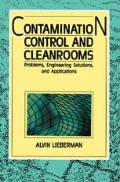Abstract
In any cleanroom, the HVAC (heating, ventilating, and air conditioning) system, the air filters, and the airflow controls are crucial to good operation. The HVAC system must be capable of providing a uniform flow of conditioned air at sufficient velocity and pressure to overcome the airflow resistance of the air ducts, air conditioning components, and filters. Very large airflow is required for modern-day cleanrooms. Even for a mixed-flow class 100,000 cleanroom, sufficient airflow to provide 20 to 30 air changes per hour may be required. A mixed-flow cleanroom that is 50 feet wide and 100 feet deep with a 10-foot ceiling requires a blower system capable of providing at least 17,000 cubic feet per minute airflow for this air change rate. The airflow should be provided at a pressure at least 0.5 inches water above ambient to assure maintenance of positive pressure in the cleanroom and to overcome the pressure drop of the filters and the HVAC components. A vertical unidirectional flow cleanroom of the same size requires a much larger blower system. For a 5,000-square-foot room with 100% filter ceiling, the airflow requirement is 450,000 cubic feet per minute for the 90-feet-per-minute air velocity specified for such cleanrooms. Energy costs just to operate the blowers to provide this airflow make up an important part of cleanroom costs.
Access this chapter
Tax calculation will be finalised at checkout
Purchases are for personal use only
Preview
Unable to display preview. Download preview PDF.
References
Abuzeid, S., Busnaina, A. A., & Ahmadi, G., 1990. Numerical Simulations of Particle Deposition from a Point Source in Turbulent Flow. Proceedings of the 36th Institute of Environmental Science Annual Technical Meeting, pp. 295–302, April 1990, New Orleans.
Asada, T., 1988. An Experimental Study on Deterioration Model of HEPA Filter in a Current Clean Room. Proceedings of the 9th International Committee of Contamination Control Societies Conference, pp. 156–159, September 26, 1988, Los Angeles.
Avery, R. H., 1984. Changing Contaminated HEPA Filters with Bag-in/Bag-out Housings. Pharmaceutical Manufacturing 1(7): 18–21.
Burchsted, C. A., et al., editors, 1976. Nuclear Air Cleaning Handbook, Energy R&D Administration Publication 76–21. Oak Ridge, TN: Oak Ridge National Laboratories.
Busnaina, A. A., Abuzeid, S., & Sharif, M. A. R., 1988. Numerical Modeling of Fluid Flow and Particle Transport in Clean Rooms. Proceedings of the 9th International Committee of Contamination Control Societies Conference, pp. 600–607, September 26, 1988, Los Angeles.
Cattaneo, D. J., 1984. HVAC and the Clean Room. Pharmaceutical Engineering 4(6):42–45.
Cucu, D. D., & Lippold, H. J., 1984. Electrostatic HEPA-Filter for Particles 0.1 μm. Proceedings of the 30th Institute of Environmental Science Annual Technical Meeting, pp. 74–78, May 1984, Orlando, FL.
Delli Paoli, A., 1986. Control of Humidity in Cleanrooms. Medical Device and Diagnostic Industry 8(4):55–59.
Gallo, E. J., Ramsey, J. W., & Liu, B. H. Y., 1988. Flow Visualization Studies in Clean Rooms. Proceedings of the 9th International Committee of Contamination Control Societies Conference, pp. 637–645, September 26, 1988, Los Angeles.
Gerbig, F. T., 1984. Energy Consumption in Vertical Laminar-Flow Cleanrooms. Microcontamination 2(3):50–55.
Japuntich, D. A., 1985. Disk-Drive Recirculation Filtration System Evaluation. Microcontamination 3(l):52–56.
Kuehn, T. H., 1988. Computer Simulation of Airflow and Particle Transport in Cleanrooms. Journal of Environmental Science 31(5):21–27.
Kuehn, T. H., et al., 1988. Comparison of Measured and Predicted Airflow Patterns in a Cleanroom. Proceedings of the 9th International Committee of Contamination Control Societies Conference, pp. 331–336, September 26, 1988, Los Angeles.
Ljungqvist, B., 1988. Air Movements: The Dispersion of Pollutants in Theory and Reality. Proceedings of 9th International Committee of Contamination Control Societies Conference, pp. 594–599, September 26, 1988, Los Angeles.
Melchert, H., & Hogh, J., 1985. Examples of Application of Laminar Flow Technology in the Pharmaceutical Industry. Swiss Pharma 7(lla):43–48.
Oh, H. D., Lim, H. K., & Lee, Y. L., 1990. Unsteady Propagation of Contamination Particles in the Turbulent Flow Field for the Dynamic Analysis of Clean Rooms. Proceedings of the 36th Institute of Environmental Science Annual Technical Meeting, pp. 283–289, April 1990, New Orleans.
Otake, N., & Watanabe, N., 1988. Development of HEPA Filter Applicable to High Temperature up to 400° C. Proceedings of the 9th International Committee of Contamination Control Societies Conference, pp. 180–182, September 26, 1988, Los Angeles.
Perez, G., 1986. Optimizing HVAC Systems through a Testing, Balancing and Adjusting Program for Environmental Systems. Pharmaceutical Manufacturing 3(2):23–26.
Sadjadi, R. S. M., & Liu, B. Y. H., 1990. Supply Plenum and Air Flow Uniformity in Cleanrooms. Proceedings of the 36th Institute of Environmental Science Annual Technical Meeting, pp. 157–162, April 1990, New Orleans.
Schicht, H. H., 1988. Engineering of Clean Room Systems: General Design Principles. Swiss Contamination Control 1(6): 15–20.
Schneider, R. K., 1984. Energy Conservation in Clean Room Design. Proceedings of the 30th Institute of Environmental Science Annual Technical Meeting, pp. 112–116, May 1984, Orlando, FL.
Settles, G. S., & Via, G. G., 1988. A Portable Schlieren System for Clean-Room Airflow Analysis. Journal of Environmental Science 30(5): 17–21.
Yamamoto, T., Donovan, R. P., & Ensor, D. S., 1988. Model Study for Optimization of Cleanroom Airflows. Journal of Environmental Science 31(6):24–29.
Rights and permissions
Copyright information
© 1992 Van Nostrand Reinhold
About this chapter
Cite this chapter
Lieberman, A. (1992). HVAC Filter and Flow Control Systems for Cleanrooms. In: Contamination Control and Cleanrooms. Springer, Boston, MA. https://doi.org/10.1007/978-1-4684-6512-9_16
Download citation
DOI: https://doi.org/10.1007/978-1-4684-6512-9_16
Publisher Name: Springer, Boston, MA
Print ISBN: 978-1-4684-6514-3
Online ISBN: 978-1-4684-6512-9
eBook Packages: Springer Book Archive

